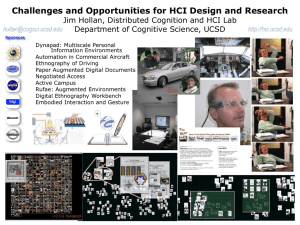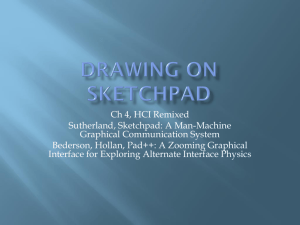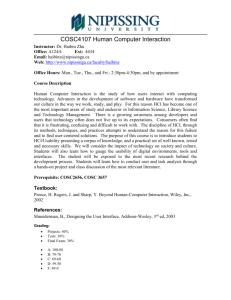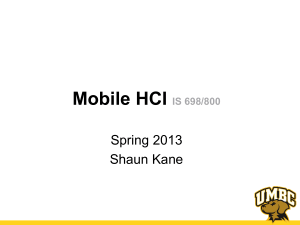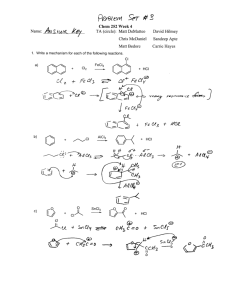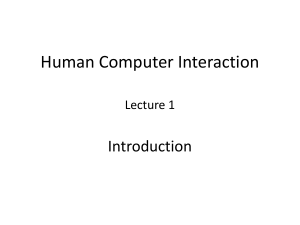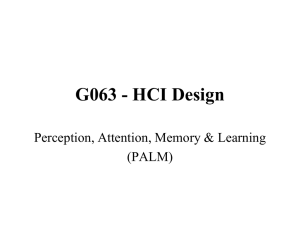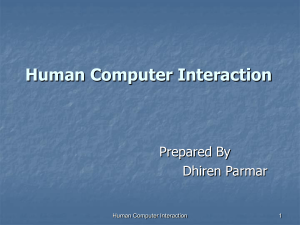Global Applications
advertisement
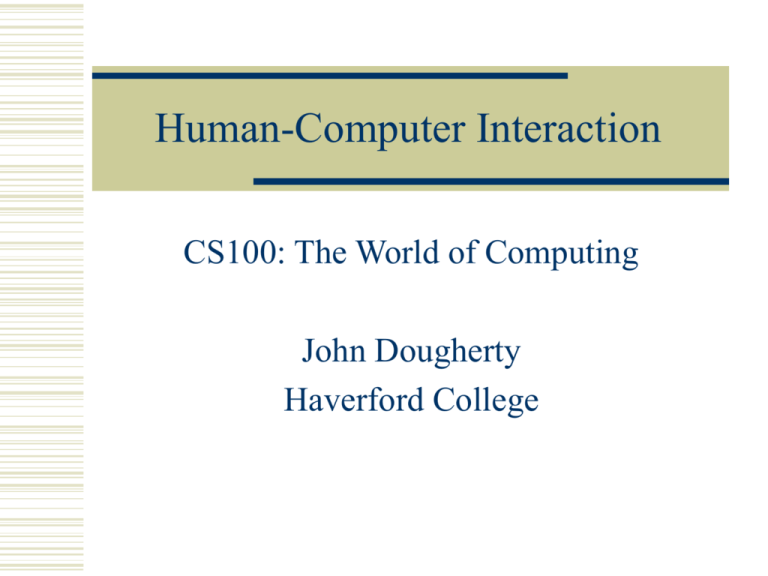
Human-Computer Interaction CS100: The World of Computing John Dougherty Haverford College Overview of HCI HCI and user-centered development Human perception and memory Content and visual organization Navigation Color and multimedia issues Accessibility Globalization [lecture based on McCraken & Wolfe, 2002] Definitions of HCI “A discipline concerned with the design, evaluation, and implementation of interactive computing systems for human use and with the study of major phenomenon surrounding them.” [SIGCHI, 1992] “HCI is the study and the practice of usability.” [Carroll, 2002] Goals of HCI Safety - of users, of data Utility - services are provided Effectiveness - easy to find and use services Efficiency - how quickly users can work Usability - ease of learning and use Appeal - how well user like the interface from first impression to long-term satisfaction Brief History of HCI Human Factors in Computer Systems [1982] Grew out of Software engineering Software psychology and human factors Graphics and user interfaces Cognitive science (e.g., GOMS: goals, operators, methods and selection [1983]) User-Centered Development Distinct from traditional SW development User-centric: user over data, user as part of design team Interdisciplinary: art, psychology, technical writing, computer science, cognitive science Highly iterative: design, implement, test, learn, redesign, … Human Capabilities and HCI Senses and perception What we see and what we recall (meaning) Memory Sensory, long-term, short-term Chunking Recognition vs. recall Interruptions Mental models and metaphors Perceived affordance Implications for HCI Design Lessen memory burden of user Use recognition, chunk information Provide visual cues/memory aids to help resume interrupted tasks Provide feedback Input received Approximate time to process Incremental metaphor and completion/failure Content Organization Exact schemes alphabetical, chronological, geographical Ambiguous schemes Topical, task-oriented, audience-specific Metaphor-driven, hybrid Structures Linear, hierarchy, database, hyperlink Visual Organization Proximity - spatially close items are perceived as related Alignment - outline to express organization Consistency - across pages in a site, as well as within a page (buttons, font) Contrast - distinguish different items, and use size, color; make it visually-clear Navigation Issues Site-level Hierarchy vs. hyperlink Build context where possible Navigation bars, menus Page-level Links with a page Frames Issues of Color Physics and perception Models of color RYB: primary colors RGB: additive color CMYK: subtractive color HSB: hue, saturation and brightness Issues of color harmony Color to organize content Multimedia Audio - music, speech, sound Formats: .wav, .au, .aiff, mid, .mp3, .ra Video - impractical for most browsers Animation - graphics over time Video format Vector format Program/Script (Java, JavaScript) 3D animation soon ??? Accessibility/Universal Design Universal design works for more people Some US statistics (2002): 8 million blind/visually impaired 20 million deaf/hearing impaired 250 thousand with spinal cord injuries 500 thousand with cerebral palsey 333 thousand with multiple sclerosis 34.8 million seniors (≥65) now, near 54 million by 2020, and 50% impaired Vision Issues Blindness Text to speech, HTML table markup Low vision Text enlargers, screen magnifiers Color blindness Avoid red/green confusion, contrast brightness Photosensitive epilepsy Avoid flashing text, animation Mobility Issues Assistive technology Sticky Keys predictive typing larger physical interface devices speech recognition Alternative pointing devices Eye-gaze, head wand, mouth stick, temporal select For web, ensure keyboard-only navigation Hearing Impairment Issues Captioned audio (open, closed) Web options SMIL (W3C) QuickTime (Apple) SAMI (Microsoft) American Sign Language (ASL) Video, avatar Globalization Internationalization Identify cultural items Localization Add cultural items to provide context Translation Personalization vs. privacy Concluding Remarks on HCI Important & emerging Interdisciplinary, add .. AI, media, networking Promote effective leveraging of computing for people Computer should adapt to people
